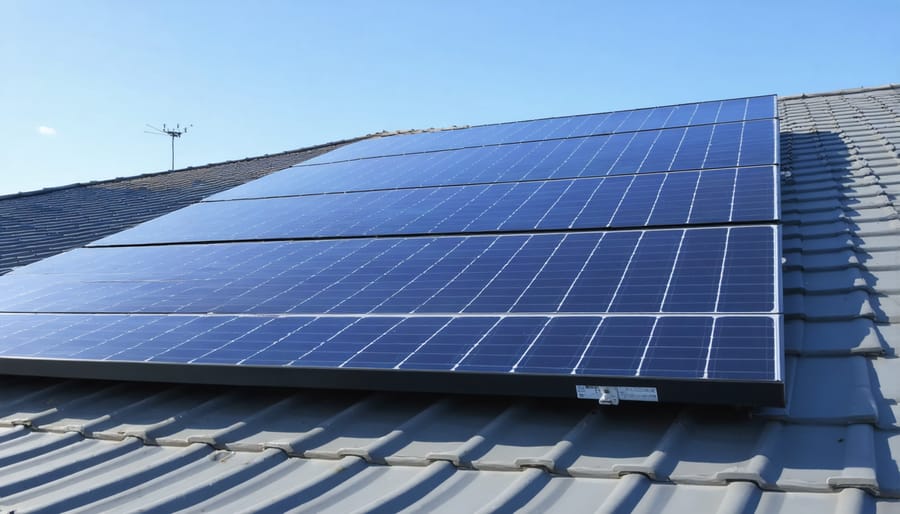# Perovskite Solar Cells Efficiency: The Game-Changing Technology Reshaping Australia’s Energy Future
In just over a decade, perovskite solar cells have shattered expectations, rocketing from 3.8% efficiency in 2009 to an astonishing 26.1% today—rivaling traditional silicon panels that took 70 years to perfect. This remarkable trajectory isn’t just a laboratory curiosity; it represents a fundamental shift in how Australia can harness the sun’s abundant energy.
Picture solar panels that cost half as much to manufacture, weigh a fraction of conventional panels, and can be printed onto flexible surfaces—applied to curved roofs, vehicle surfaces, or even building windows. That’s the promise perovskite technology delivers, combining a crystal structure material (calcium titanium oxide) with organic compounds to create cells that absorb sunlight across a broader spectrum than silicon ever could.
For Australian households and businesses already leading the world in rooftop solar adoption, perovskite cells offer an electrifying next chapter. Current research shows tandem cells—layering perovskite atop silicon—achieving efficiencies exceeding 33%, squeezing significantly more power from the same rooftop space. With Australia’s solar irradiance among the planet’s highest, these efficiency gains translate directly into faster payback periods and greater energy independence.
Yet efficiency numbers tell only part of the story. The real breakthrough lies in perovskite’s versatility and manufacturing simplicity, potentially democratizing solar technology for communities previously locked out by high costs. As stability challenges are progressively solved through advanced encapsulation techniques, perovskite cells are transitioning from promising prototype to commercial reality—and Australia’s positioned perfectly to capture this solar revolution.
What Makes Perovskite Solar Cells Different (And Why Everyone’s Talking About Them)
If you’ve been keeping an eye on solar energy developments, you’ve probably heard perovskite solar cells mentioned as the technology that could revolutionize renewable energy. But what exactly makes them so special compared to the silicon panels we’ve been using for decades?
Traditional silicon solar panels rely on highly purified silicon crystals—a material that requires intensive manufacturing processes, high temperatures (around 1,400°C), and considerable energy input. Think of silicon panels as the carefully crafted, expensive watches of solar technology: precise, reliable, but costly to produce.
Perovskite solar cells, by contrast, are the game-changers. Named after a crystal structure discovered in Russia’s Ural Mountains, perovskites are a class of materials with a unique atomic arrangement that’s exceptionally good at absorbing sunlight and converting it into electricity. The beauty lies in their simplicity—these cells can be manufactured at room temperature using solution-based processes, similar to printing ink on paper. Imagine coating a surface with solar-capturing material as easily as painting a wall.
This manufacturing simplicity translates to significantly lower production costs and reduced energy consumption during fabrication. While silicon panels need specialized facilities and complex production lines, perovskite cells can potentially be produced using roll-to-roll printing techniques, making them far more accessible and scalable. They’re also incredibly thin and lightweight—about 1,000 times thinner than silicon panels—opening possibilities for flexible solar applications.
What’s particularly exciting is how perovskites can work alongside existing technologies. Similar to advances in quantum dot technology, perovskites can be layered with traditional silicon cells to capture different parts of the light spectrum, potentially pushing efficiency levels beyond what either technology could achieve alone.
For Australian conditions—with our abundant sunshine and growing demand for affordable renewable energy—perovskite technology represents a fair dinkum opportunity to accelerate our clean energy transition while reducing costs for households and businesses alike.

The Efficiency Race: How Perovskite Cells Are Breaking Records
Tandem Cells: The Game-Changing Combination
Think of it like a two-person relay team where each runner excels at different distances. That’s essentially what tandem solar cells do—they combine perovskite and silicon layers to capture different parts of the sun’s spectrum, maximising energy harvest in a way neither material could achieve alone.
Traditional silicon solar panels are brilliant at converting red and infrared light but struggle with the blue end of the spectrum. Perovskite, meanwhile, excels at capturing that blue light. When researchers stack these materials together, the top perovskite layer absorbs the high-energy photons whilst allowing lower-energy light to pass through to the silicon layer below. It’s a beautiful partnership that’s already delivering remarkable results.
Recent breakthroughs have pushed tandem cell efficiencies beyond 33%—smashing through the theoretical limit of silicon-only cells. Australian researchers at the University of New South Wales have been at the forefront of this innovation, contributing to record-breaking efficiency gains that are turning heads globally.
What makes this particularly exciting is the practical application. These tandem cells could generate significantly more electricity from the same rooftop space, meaning homeowners and businesses can produce more clean energy without needing additional panels. For sun-drenched Australia, where rooftop real estate is prime territory, this technology could accelerate our renewable energy transition whilst reducing installation costs per watt generated—a genuine win-win for sustainability and affordability.
Real-World Performance vs. Lab Results
While perovskite solar cells have achieved remarkable efficiency records exceeding 26% in controlled laboratory environments, translating these results to rooftop installations presents unique challenges—particularly under Australia’s demanding conditions.
The gap between lab and field performance stems from several factors. Laboratory tests occur under standardised conditions: precisely 25°C temperature, controlled humidity, and consistent light exposure. However, Australian rooftops tell a different story. Solar panels in Darwin regularly experience temperatures above 60°C, while coastal installations in Sydney and Brisbane face salt-laden humidity that can degrade sensitive materials.
The good news? Australian researchers are leading the charge in closing this gap. Teams at the University of New South Wales and CSIRO are specifically testing perovskite cells under harsh Australian conditions, developing protective encapsulation techniques that shield the cells from moisture and intense UV radiation—challenges our sunburnt country knows well.
Recent field trials in Queensland have shown promising results, with modified perovskite panels maintaining over 90% of their initial efficiency after twelve months of exposure to tropical conditions. Researchers have discovered that combining perovskites with silicon in tandem cells not only boosts efficiency but also improves stability under heat stress.
The key breakthrough involves protective coatings and hybrid designs that embrace rather than fight Australia’s climate. While commercial perovskite panels aren’t quite ready for widespread installation, these real-world trials demonstrate that laboratory promise is steadily becoming practical reality, tailored specifically for Australian conditions.
Why Higher Efficiency Matters for Your Home and Business
The remarkable efficiency gains in perovskite solar cells aren’t just laboratory achievements—they’re set to transform how Australian homes and businesses harness the sun’s power. Here’s what this breakthrough means for your energy future.
**More Power, Less Space**
Traditional solar panels require significant roof space to generate enough electricity for an average household. With perovskite cells delivering higher efficiency rates, you’ll need fewer panels to produce the same energy output. For a typical Australian home consuming 20kWh daily, this could mean reducing your solar array from twenty panels to fifteen or fewer. This is brilliant news for townhouses, smaller commercial properties, or heritage homes where roof space comes at a premium.
**Reduced Upfront Investment**
Fewer panels translate directly to lower installation costs. The savings cascade through reduced mounting equipment, simplified installation labour, and less structural reinforcement. Early projections suggest households could save $2,000 to $4,000 on initial setup costs once perovskite technology reaches commercial scale. For businesses, these savings multiply significantly across larger installations.
**Greater Energy Independence**
Higher efficiency means capturing more energy during peak sunlight hours, which is particularly valuable during Australia’s scorching summers when air conditioning demand soars. When paired with energy storage solutions, perovskite panels could help you achieve true energy self-sufficiency, insulating your household or business from rising electricity prices and grid instability.
**Real-World Success**
Consider Sarah, a Melbourne café owner who’s been eyeing solar but lacks sufficient roof space around her ventilation systems. Perovskite technology could finally make her solar dreams viable, potentially cutting her $800 monthly electricity bill by 70% whilst demonstrating environmental leadership to her customers. These practical applications showcase how efficiency improvements create opportunities previously beyond reach.

Success Stories: Where Perovskite Technology Is Already Making Waves
While perovskite solar cells might sound like tomorrow’s technology, they’re already proving their worth in real-world applications across Australia and beyond. These success stories demonstrate that this isn’t just laboratory science—it’s tangible progress happening right now.
In Australia, researchers at the University of New South Wales have achieved remarkable milestones, creating prototype panels that maintain over 25% efficiency even after rigorous testing. Their work has caught the attention of local manufacturers exploring commercial production pathways. Meanwhile, at Monash University, scientists have developed perovskite modules specifically designed to withstand Australia’s harsh UV radiation and temperature extremes—a critical breakthrough for our climate.
The excitement extends beyond research labs. Oxford PV, a British company that’s become a global leader in perovskite technology, has begun producing commercial panels at their German facility. Their tandem cells—combining perovskite with traditional silicon—have reached an impressive 28% efficiency in production, significantly outperforming conventional panels. These aren’t prototypes gathering dust; they’re being installed in real buildings, generating genuine power.
In Poland, Saule Technologies has taken a different approach, printing flexible perovskite cells that can be integrated into building facades and even curved surfaces. Imagine office buildings where every wall becomes a power generator—that’s the potential these pioneers are unlocking. Their pilot installations across Europe have already demonstrated how perovskite technology can transform urban architecture into energy infrastructure.
Closer to home, Australian startup SunDrive has been making waves by developing copper-based solar technology that complements perovskite research. While they’re focused on silicon cells currently, their innovations create pathways for hybrid technologies combining the best of both worlds.
These projects represent more than technical achievements—they’re proof that Australia can compete globally in emerging energy innovations. Each successful deployment builds confidence among investors, manufacturers, and consumers that perovskite solar technology deserves a place in Australia’s renewable energy future. The transition from laboratory curiosity to rooftop reality is accelerating, bringing us closer to affordable, highly efficient solar power that works brilliantly under our abundant sunshine.
The Challenges We’re Still Solving
Let’s be fair dinkum about this—while perovskite solar cells are absolutely brilliant, they’re not quite ready to replace your rooftop panels tomorrow. The exciting news? Researchers across Australia and worldwide are tackling these challenges head-on, and we’re seeing remarkable progress.
The biggest hurdle remains durability. Traditional silicon panels last 25-30 years, while early perovskite cells degraded within months when exposed to moisture, oxygen, and heat. Think of them as having needed a bit more resilience against our harsh Australian climate. However, recent breakthroughs have extended their lifespan significantly—some lab versions now maintain performance for over two years under real-world conditions, with commercial targets of 20+ years looking increasingly achievable.
Then there’s the lead content question. Most high-efficiency perovskite cells contain small amounts of lead, which understandably raises environmental eyebrows. The good news? Scientists are developing lead-free alternatives using tin and other materials, while others are perfecting encapsulation methods that would safely contain any lead throughout the panel’s lifecycle and enable complete recycling.
Manufacturing at scale presents another puzzle. Moving from laboratory samples the size of postage stamps to full-sized panels requires new production techniques. Australian companies and research institutions are pioneering roll-to-roll printing methods—imagine printing solar cells like newspaper—which could dramatically reduce costs and energy inputs compared to traditional solar manufacturing.
These aren’t roadblocks; they’re the final steps in an innovation journey. Every challenge is receiving focused attention and funding, with practical solutions emerging regularly. The path from laboratory curiosity to commercial reality always involves overcoming obstacles—and perovskite technology is progressing faster than most energy innovations in history.

What This Means for Australia’s Renewable Energy Goals
Australia’s ambitious target to achieve net-zero emissions by 2050 requires a complete transformation of our energy landscape, and perovskite solar technology could be the game-changer we’ve been waiting for. With the nation blessed by some of the world’s best solar resources—averaging over 58 million petajoules of solar radiation annually—harnessing this energy more efficiently puts our renewable goals well within reach.
The breakthrough efficiency of perovskite cells means Australian households and businesses can generate more power from smaller rooftop installations, making solar accessible even in space-constrained urban environments. This is particularly significant for apartment buildings and commercial properties that previously couldn’t justify solar investment due to limited roof area.
Beyond individual installations, perovskite technology opens extraordinary opportunities for local manufacturing. The simpler, lower-temperature production process compared to traditional silicon cells means we could establish competitive solar manufacturing facilities right here on Australian soil. This translates to thousands of jobs in research, manufacturing, installation, and maintenance—creating a homegrown clean energy industry that keeps expertise and economic benefits local.
Australian research institutions are already at the forefront of this revolution. The University of Sydney and CSIRO have made significant contributions to perovskite stability research, positioning Australia as a global innovation hub. Continued investment in this sector could cement our reputation as leaders in renewable energy technologies, attracting international collaboration and investment.
The synergy between perovskite solar and emerging technologies like solar-powered hydrogen production creates even more exciting possibilities. Higher efficiency panels mean more cost-effective hydrogen generation, potentially transforming Australia into a clean energy export powerhouse.
Most importantly, perovskite advancement accelerates our fossil fuel transition timeline. What seemed decades away might now be achievable within years, giving us realistic hope of protecting our unique environment while building energy independence. The technology isn’t just about better panels—it’s about securing a cleaner, more prosperous future for all Australians.
Perovskite solar cells represent nothing short of a renewable energy revolution, with efficiency rates now rivaling and sometimes surpassing traditional silicon technology. For Australia—a nation blessed with some of the world’s most abundant sunshine—this breakthrough couldn’t come at a better time. We’re perfectly positioned to harness this game-changing technology, transforming our natural advantage into clean, affordable energy that powers homes, businesses, and our collective future.
The journey from laboratory curiosity to commercial reality is well underway, with Australian researchers and companies playing crucial roles in bringing these ultra-efficient cells to market. Success stories from pilot projects across the country demonstrate that perovskite technology isn’t just theoretical—it’s practical, scalable, and ready to make a real difference.
Now is the time to stay informed and engaged with these developments. Whether you’re a homeowner considering solar options, a business leader evaluating sustainability initiatives, or simply someone who cares about our planet’s future, supporting renewable energy innovation matters. Follow Australian research institutions, advocate for policies that encourage clean energy adoption, and consider how your choices today can accelerate our transition to a sustainable tomorrow. The sun shines brightly on Australia’s renewable energy future—let’s make the most of it.

